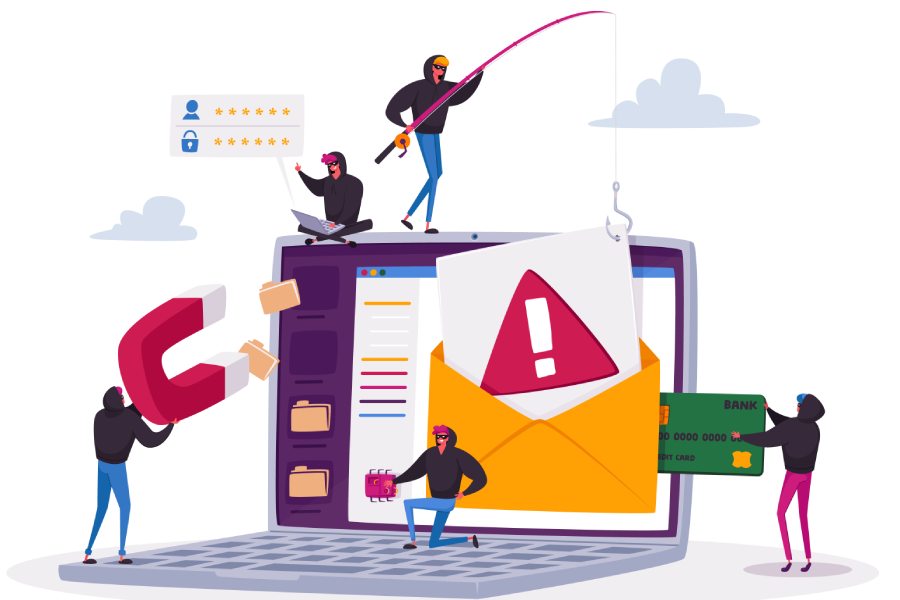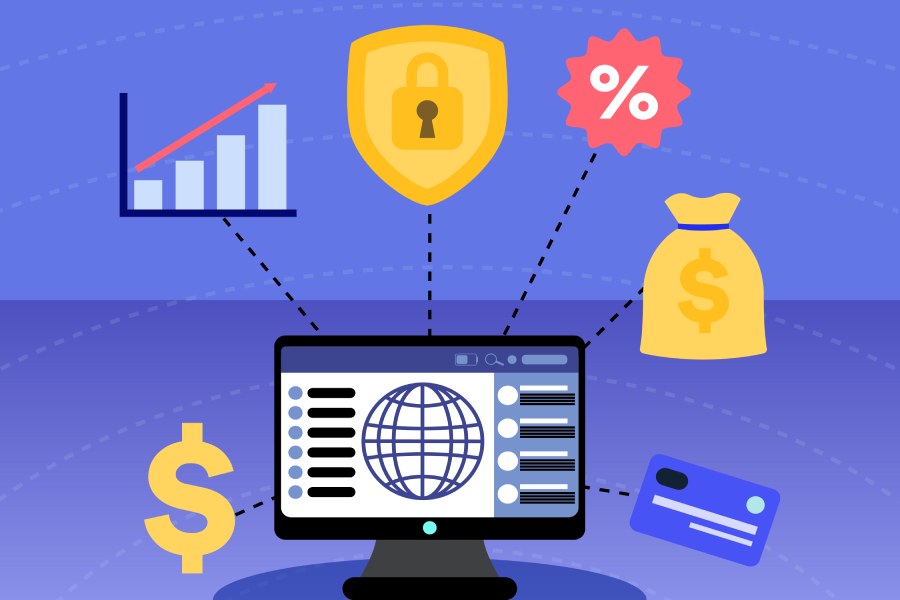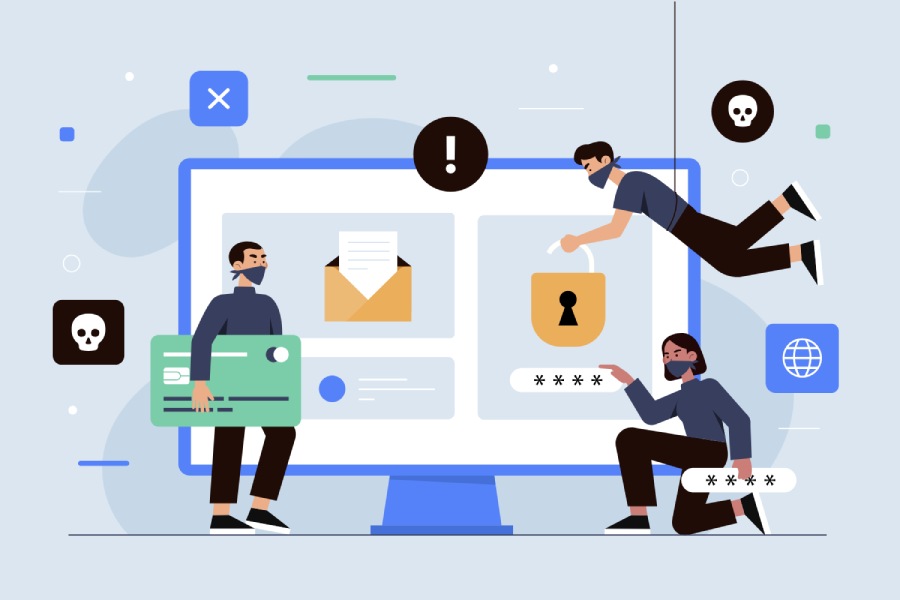by Brad | Jun 10, 2025 | Phishing, Phishing Awareness
Brad’s Bottom Line Up Front:
1. Fortify the “Human Firewall” (Highest Priority)
This is the most critical and cost-effective area. Since these attacks manipulate people, your team is your best defense.
- Champion “Out-of-Band” Verification: This is your number one rule. Train every employee that any unexpected or urgent request for money, credentials, or data must be verified through a separate channel. If an email from the “CEO” asks for a wire transfer, you don’t reply to the email—you call the CEO on their known phone number or message them on your internal chat tool to confirm.
- Conduct Practical Training: You don’t need a complex system. Run short, regular training sessions using real-world examples. Explain that emails from trusted domains like Gmail or even Microsoft can be hijacked. The goal isn’t just awareness, but building a culture of healthy skepticism.
- Establish Simple, Blame-Free Reporting: Create a simple email address (like
phishing@yourcompany.com) where employees can forward anything that looks suspicious. When they do, thank them. Making reporting easy and safe turns every employee into a sensor for your business.
2. Implement Foundational (and Often Free) Technical Controls
You can dramatically improve security by enabling controls that are likely already available to you.
- Enforce Multi-Factor Authentication (MFA) Everywhere: This is non-negotiable. Even if an attacker steals a password, MFA can stop them from getting in. Use free authenticator apps like Google Authenticator or Microsoft Authenticator for all critical services (email, banking, cloud storage).
- Use Basic Email Authentication for Your Domain: Implement SPF, DKIM, and DMARC. These are free DNS settings that make it much harder for attackers to spoof your company’s email address to phish your customers or partners. There are many free online wizards and guides to help set these up.
- Keep Everything Updated: One of the most common ways attackers get in is through unpatched software. Enable automatic updates on all computers, web browsers, and applications. This is a free and highly effective defensive measure.
- Use DNS Filtering: A DNS filter can automatically block connections to known malicious websites. Services like Quad9 are free and can be set up on your office router to protect everyone automatically.
3. Establish Simple, Effective Processes
Good security is also about having clear plans.
Introduction: The Shifting Sands of Phishing—When Trust Becomes a Weapon
The digital threat landscape is in a state of perpetual evolution, yet for years, one attack vector has remained stubbornly persistent and effective: phishing. It is the common thread that runs through a vast number of security incidents, often serving as the initial point of entry for more devastating offensives like ransomware deployment, industrial espionage, and large-scale data breaches. The enduring success of phishing lies in its masterful exploitation of human psychology, crafting personalized and convincing narratives that compel victims to take actions against their own interests. However, the classic image of a phishing attack—an email riddled with grammatical errors, sent from a suspicious address, and containing a blatantly dubious link—is becoming dangerously obsolete. A new, more insidious paradigm has emerged, one where threat actors no longer simply fake legitimacy but actively co-opt and weaponize it.
This evolution has been dramatically accelerated by the widespread availability of sophisticated tools and technologies. The rise of generative artificial intelligence, for instance, has supercharged attackers’ capabilities, leading to a staggering 4,151% increase in phishing volume since late 2022. AI enables the creation of flawless, contextually relevant lures that are devoid of the traditional red flags users have been trained to spot. This technological advancement is coupled with a strategic shift in the cybercrime economy itself. The proliferation of Phishing-as-a-Service (PhaaS) platforms and advanced, ready-to-use phishing kits has professionalized the attack lifecycle. This development lowers the barrier to entry, allowing less-skilled actors to deploy highly sophisticated campaigns that were once the exclusive domain of advanced persistent threat (APT) groups. The modern organization is not merely defending against individual hackers but against a mature, illicit service-based economy that provides potent attack capabilities on demand.
Nowhere is this new reality more clearly illustrated than in the global phishing campaign that abused the infrastructure of Nifty.com. Between April and May of 2025, a multi-wave attack targeted hundreds of organizations, particularly in the financial services, technology, and healthcare sectors. This was not a simple domain spoofing operation. The attackers leveraged legitimate accounts on a trusted platform, allowing their malicious emails to sail past standard security defenses that rely on authentication protocols like SPF, DKIM, and DMARC. The Nifty.com campaign serves as a quintessential case study in this evolved threat, demonstrating how the very fabric of digital trust can be turned into a weapon.
This report provides a definitive analysis of this new attack paradigm, using the Nifty.com campaign as a detailed lens. It will first deconstruct the technical anatomy and social engineering tactics that made the campaign so effective. It will then broaden the scope to show how the abuse of legitimate infrastructure is a pervasive trend affecting major cloud and service providers. Finally, it will present a comprehensive, multi-layered corporate defense framework designed to provide genuine resilience against this modern class of trust-based attacks, moving beyond outdated advice to equip organizations for the challenges ahead.
Section 1: Deconstructing the Nifty.com Phishing Campaign
1.1. The Attack Vector: Abusing a Trusted Domain
The foundational element that defined the Nifty.com phishing campaign and made it so effective was its clever choice of attack vector. The threat actors did not engage in traditional domain spoofing or typosquatting, techniques that security systems and savvy users are increasingly adept at detecting. Instead, they weaponized trust by operating from within a legitimate, established domain: nifty.com.
The attackers legitimately registered free consumer accounts on nifty.com, a well-known Japanese Internet Service Provider (ISP). By doing so, they gained the ability to send emails that originated from Nifty’s own mail servers (e.g., mta-snd-e0X.mail.nifty.com) and were sent from the ISP’s reputable IP address ranges (e.g., 106.153.226.0/24). This seemingly simple step had profound implications for bypassing security controls. Because the emails were sent from authentic accounts on legitimate infrastructure, they successfully passed all standard email authentication checks: Sender Policy Framework (SPF), DomainKeys Identified Mail (DKIM), and Domain-based Message Authentication, Reporting, and Conformance (DMARC). This rendered an entire class of legacy email security gateways ineffective, as these systems are heavily reliant on failed authentication checks as a primary indicator of a malicious or spoofed email. The emails arrived in user inboxes with all the technical markers of a legitimate message, cloaking them in an aura of authenticity that was difficult to penetrate.
A crucial point of clarification is the distinction between the abused service and a similarly named platform. The domain exploited by the attackers was nifty.com, the Japanese ISP. This is a separate and distinct entity from niftypm.com, a project management Software-as-a-Service (SaaS) platform. NiftyPM has undergone extensive security validation, holding certifications such as SOC 2 and ISO 27001, and was not compromised in any way. The attackers’ choice to leverage the ISP demonstrates a sophisticated understanding of brand association. They deliberately chose a “soft target”—a public-facing service offering free accounts—that shared a name with a trusted corporate brand, knowing that the name “Nifty” would lend credibility to their campaign.
This tactic highlights a subtle but critical vulnerability surface: brand reputation “splash damage.” An organization’s brand and the trust it commands are significant assets. This campaign demonstrates that these assets can be targeted indirectly. By compromising or abusing a less-secure, publicly accessible service that shares a brand name or affiliation with a highly secure corporate entity, threat actors can leverage the trust associated with the primary brand to enhance the legitimacy of their attacks.
This creates a new dimension of risk where the security posture of any entity sharing a brand identity can become a potential liability. Investing in strong logo design helps maintain a consistent visual identity, making it easier for customers to recognize official communications and avoid impersonation attempts. It underscores the need for organizations to expand their security considerations beyond their own perimeter to include proactive brand protection and defensive domain registration, transforming these from purely marketing functions into essential components of a holistic security strategy.
1.2. Anatomy of the Attack: A Multi-Wave, Evasive Campaign
The Nifty.com campaign was not a single, isolated event but a meticulously planned and adaptive operation executed over several weeks. Its anatomy reveals a multi-stage process designed for maximum evasion, combining sophisticated technical obfuscation with clever payload delivery to bypass both automated defenses and human scrutiny.
Analysis of the campaign timeline shows a series of distinct but related waves occurring between late April and late May 2025. The attacks began with lures themed around an “Execution Agreement,” followed by subsequent waves using the same theme before introducing a variant centered on a “SAFE agreement.” The repetition, timing, and adaptation of lures strongly suggest the use of an automated phishing kit, allowing the attackers to orchestrate high-volume bursts of activity with minimal manual effort.
The payload delivery method was a key element of the campaign’s evasive design. Instead of embedding a malicious link directly in the email body—a common tactic that many email filters are programmed to detect—the attackers hid their payload within attachments. These attachments were typically .html or .pdf files with innocuous, business-oriented filenames like SAFE_Terms_May2025.pdf. This approach is designed to circumvent simple URL scanners that only parse the text of an email, forcing security systems to inspect the content of the files themselves, a more resource-intensive task.
Once a user opened the attachment, they were sent down a complex, multi-layer redirection chain—an “evasion gauntlet” designed to shake off automated analysis tools. A typical chain began with a click that led to a legitimate-looking marketing tracker, such as one hosted on thryv.com, before redirecting to the true phishing site, which was often hosted on obscure Russian domains (e.g., [...].iqmwpx.ru) and contained heavily obfuscated JavaScript. This layering makes it difficult for a security sandbox to follow the full path to its malicious conclusion, as the initial hop appears benign.
To further fortify their attack against analysis, the threat actors integrated a suite of advanced evasion techniques into the intermediate and final landing pages. These included:
- Anti-Analysis and Anti-Sandboxing: The pages used JavaScript-based browser fingerprinting to gather information about the client environment. This was combined with time-based redirection deferrals (delaying the redirect to see if it was being rushed by an automated system) and virtual machine artifact checking, which looks for signs that the code is being run in a sandbox rather than on a real user’s machine. If analysis was detected, the malicious redirect would be aborted.
- Content Obfuscation: Within the malicious attachments, attackers employed techniques like HTML padding, which involves inserting large amounts of whitespace characters to confuse and bypass content filters. They also used multipart MIME structures to further conceal the payload within the file’s architecture.
- Perceived Legitimacy: The final destination—the credential harvesting page—was not a hastily constructed fake. These pages were professionally designed to masquerade as legitimate login portals and, crucially, were secured with valid SSL certificates. The presence of the padlock icon in the browser’s address bar is a powerful psychological cue that users have been trained to associate with safety, making the final deception all the more convincing.
The following table synthesizes the various tactics, techniques, and procedures (TTPs) employed throughout the Nifty.com campaign, providing a structured overview for security professionals.
| Tactic |
Technique |
Description & Purpose |
| Initial Access |
Abuse of Trusted Infrastructure |
Attackers used legitimate nifty.com ISP accounts to send emails, ensuring they passed SPF/DKIM/DMARC checks and bypassed reputation-based filters. |
| Execution |
Malicious Attachment |
The payload was delivered via .html or .pdf attachments, avoiding direct malicious links in the email body to evade simple scanners. |
| Defense Evasion |
Multi-Layer Redirection |
A chain of redirects, starting with a benign tracker, was used to obfuscate the final malicious destination from automated security tools. |
| Defense Evasion |
Anti-Analysis Techniques |
Implemented browser fingerprinting, VM checking, and time-based deferrals to detect and bypass automated sandboxing environments. |
| Defense Evasion |
Obfuscated Files/Information |
HTML padding and multipart MIME structures were used within attachments to hide malicious code from content-based filters. |
| Credential Access |
Credential Harvesting |
The final landing page was a professionally designed, SSL-secured portal intended to steal user credentials and session tokens. |
| Social Engineering |
Display Name Spoofing |
The “From” field was manipulated to impersonate trusted brands like DocuSign, leveraging their reputation to increase the email’s credibility. |
1.3. The Human Element: Social Engineering and Target Profile
While the technical sophistication of the Nifty.com campaign was formidable, its success was ultimately contingent on manipulating the human element. The attackers deployed a carefully crafted social engineering strategy designed to exploit professional norms, cognitive biases, and the inherent trust users place in familiar brands and workflows.
The campaign’s lures were not generic but were specifically tailored to a corporate audience, with a focus on organizations in the financial services, technology, and healthcare sectors. The use of filenames like SAFE_Terms_May2025.pdf and Execution_Agreement.html was a deliberate choice. These terms reference common legal and financial documents, creating a powerful sense of professional obligation and context. An employee receiving an email about an “Execution Agreement” is psychologically primed to treat it as a legitimate and important work-related task, lowering their natural skepticism.
To amplify this effect, the attackers employed brand impersonation through a technique known as “display name spoofing”. While the underlying sender email address was a generic one from nifty.com, the display name shown in the user’s inbox was crafted to appear as if it came from a trusted service, such as “Name via DocuSign”. This tactic cleverly leverages the reputation of well-known brands like DocuSign, which are integral to many business workflows. By mimicking the notification format of these services, the attackers made their malicious request seem like a routine part of a standard, secure process, further disarming the target.
A final, crucial component of the social engineering was the quality of the communication itself. The emails were free of the spelling and grammatical errors that are often telltale signs of a phishing attempt. The flawless grammar and professional tone are indicative of the use of high-quality phishing kits or even AI-generation tools, which can produce convincing and contextually appropriate text at scale. By eliminating this common red flag, the attackers removed one of the last lines of defense for a user trained in basic security awareness.
The ultimate goal of this multi-faceted campaign was unambiguous: credential harvesting. The attackers sought to steal not only usernames and passwords but also active session tokens or cookies, specifically targeting Gmail sessions. The theft of session tokens is particularly dangerous as it can allow an attacker to bypass certain forms of multi-factor authentication (MFA) by hijacking an already authenticated session, granting them direct access to the victim’s account and the sensitive data within.
Section 2: The Broader Threat Landscape: Legitimate Infrastructure as the New Trojan Horse
2.1. Beyond Nifty: A Pervasive and Growing Trend
The Nifty.com campaign, while a stark example, is not an anomaly. It is a clear indicator of a dominant and accelerating trend in the cyber threat landscape: the systematic abuse of legitimate internet services (LIS) to conduct malicious operations. Threat actors, ranging from financially motivated cybercriminals to sophisticated state-sponsored groups, are increasingly choosing to operate from within the trusted confines of the global digital infrastructure. This “Living Off the Land” philosophy, which traditionally referred to attackers using pre-installed tools on a compromised endpoint to evade detection, has now expanded to encompass the very infrastructure of their attacks. The motivation is the same: to blend in with the massive volume of legitimate network traffic and bypass security controls that are designed to spot and block overtly malicious or unknown entities.
This trend is pervasive across the digital ecosystem, with threat actors exploiting a wide array of trusted platforms:
- Cloud Storage and Application Platforms: Attackers frequently leverage major cloud providers to host their malicious content. Campaigns have been observed abusing Google Cloud Storage (
storage.googleapis.com) and Microsoft Azure (blob.core.windows.net) to host phishing pages. Because these domains are highly reputable and essential for normal business operations, blocking them is not feasible. An alert for traffic to storage.googleapis.com is far less likely to be investigated than an alert for traffic to a newly registered, unknown domain, providing attackers with a powerful cloak of invisibility.
- File Hosting and Collaboration Services: The misuse of file-sharing services like Microsoft SharePoint and OneDrive is a rapidly growing attack vector. Threat actors, often operating from previously compromised vendor accounts, can host malicious files on these platforms. The service then sends a legitimate, automated email notification to the target, inviting them to access the file. The recipient sees an email from a trusted service (Microsoft) and potentially a trusted sender (the compromised vendor), making them highly likely to click the link.
- Content Delivery and Anonymization Networks: Services designed to improve web performance and privacy, such as Cloudflare and Ngrok, are regularly abused by attackers to obfuscate their command-and-control (C2) infrastructure. State-sponsored groups from China and Russia have been observed using these services to proxy their C2 traffic, making it extremely difficult for defenders to trace the true origin of the attack and block the malicious servers.
- Multi-Channel Social Engineering: The attack surface has expanded beyond email. Threat actors now conduct multi-channel phishing campaigns that leverage collaboration platforms like Slack and Microsoft Teams, as well as social media messaging, to deliver their lures.
This strategic shift fundamentally breaks security models that are built on a foundation of reputation and blacklisting. When the attack originates from a trusted Microsoft server, is hosted on Google’s infrastructure, and is proxied through Cloudflare, traditional indicators of compromise become meaningless. The challenge for security teams is no longer to differentiate “good” from “bad” domains but to perform deep contextual and behavioral analysis on traffic to and from universally “good” domains—a significantly more complex and resource-intensive task.
2.2. Traditional Phishing vs. Infrastructure-Abuse Attacks
To fully grasp the strategic challenge posed by campaigns like the one that abused Nifty.com, it is essential to draw a sharp distinction between traditional phishing methodologies and the new paradigm of infrastructure-abuse attacks. While both share the ultimate goal of deception and theft, their underlying mechanics and the defenses they bypass are fundamentally different.
Traditional phishing operates on a principle of impersonation and deception. Its effectiveness hinges on creating a convincing fake. This involves techniques such as:
- Typosquatting and Lookalike Domains: Registering domains that are slight misspellings or variations of legitimate ones (e.g.,
paypa1.com instead of paypal.com, or micros0ft-support.com).
- Domain and Email Spoofing: Forging email headers to make a message appear as if it came from a trusted sender, even though it originated from an attacker’s server.
- Homograph Attacks: Using characters from different alphabets (e.g., the Cyrillic ‘а’) that are visually indistinguishable from Latin characters to create deceptive domain names.
The primary defenses against these traditional attacks are a combination of user vigilance and technical filters. Users are trained to hover over links, check for misspellings, and scrutinize the sender’s address. Technical controls like DMARC, SPF, and DKIM are designed specifically to detect and block spoofed emails, while URL scanners and domain blacklists identify and flag known-bad or suspicious domains.
In stark contrast, infrastructure-abuse phishing operates on a principle of exploiting inherent trust. Instead of creating a fake, it compromises or misuses a legitimate entity. Key characteristics include:
- Legitimate Origin: The attack originates from a real account on a trusted platform, such as
nifty.com, gmail.com, or a corporate Microsoft 365 tenant.
- Authenticated and Verified: The emails pass all standard authentication checks (SPF, DKIM, DMARC) because they are, from a technical standpoint, authentic.
- Trusted Initial Links: The initial links in the email or attachment may point to reputable services like SharePoint, Google Drive, or well-known marketing trackers, delaying the redirect to the malicious site and evading simple URL analysis.
This methodology directly bypasses the very controls designed to stop traditional phishing. Domain reputation analysis is useless when the domain is legitimate. Email authentication provides a false sense of security. User training focused on spotting fake domains becomes irrelevant when the domain is real. Consequently, the defense against infrastructure abuse must be more advanced, focusing on behavioral and contextual analysis rather than simple reputation checks. It requires a security posture that operates under the assumption that any source, no matter how trusted, could potentially be malicious.
The following table provides a comparative analysis to crystallize the fundamental differences between these two phishing paradigms.
| Attribute |
Traditional Phishing |
Infrastructure-Abuse Phishing |
| Primary Vector |
Spoofed or lookalike domains (e.g., micros0ft.com) |
Legitimate accounts on trusted platforms (e.g., user@nifty.com, user@gmail.com) |
| Core Principle |
Impersonation and Deception |
Exploitation of Inherent Trust |
| Email Authentication |
Often fails SPF/DKIM/DMARC checks |
Passes all SPF/DKIM/DMARC checks |
| Key Bypassed Defense |
User vigilance, basic spam filters, DMARC |
Email authentication, domain reputation analysis, simple URL blacklists |
| User Psychology Exploited |
Deception, urgency, fear, curiosity |
Inherent trust in known brands and services, professional obligation, normalized workflows |
| Primary Detection Method |
Signature/reputation-based (URL blacklists, domain checks) |
Behavioral/contextual analysis (unusual sender-recipient pairs, attachment sandboxing, redirect chain analysis) |
This comparison makes it clear why infrastructure-abuse attacks represent such a significant leap in threat sophistication. They invalidate a foundational assumption of many security programs: that traffic from trusted, reputable sources is safe. For any CISO or security leader, this table should serve as a powerful justification for investing in a new generation of security technologies and training programs capable of addressing this evolved threat.
Section 3: Building a Resilient Defense: A Multi-Layered Mitigation Framework
In the face of attacks that weaponize trust and operate from within legitimate infrastructure, traditional, perimeter-focused security models are no longer sufficient. Defending the modern enterprise requires a resilient, multi-layered framework built on the principle of Zero Trust: “never trust, always verify.” This approach assumes that threats can originate from anywhere, both inside and outside the network, and that no user or system should be trusted by default. Such a framework must integrate advanced technology, fortify the human element, and implement proactive security processes.
3.1. Re-engineering the Technical Stack: A Zero Trust Approach
The first layer of a modern defense involves re-engineering the technical security stack to detect and neutralize threats that legacy systems were never designed to handle.
Advanced Email Security: Standard email filters that rely on sender reputation and signature matching are easily bypassed by infrastructure-abuse attacks. Organizations must deploy advanced email security solutions with capabilities that go deeper:
- Attachment Sandboxing: Given that the Nifty campaign delivered its payload via
.html and .pdf attachments, it is critical that all inbound attachments are automatically opened and analyzed in a secure, isolated sandbox environment. This allows the security system to observe the file’s behavior—such as initiating a network connection or attempting to execute a script—and block it before it ever reaches the user’s inbox.
- Behavioral and AI-Driven Analysis: Modern email gateways must incorporate artificial intelligence and machine learning to analyze the context and behavior of communications, not just their technical markers. This includes flagging behavioral anomalies like those seen in the Nifty campaign: unusual sender-recipient combinations (e.g., an external free-mail account sending a contract to a finance department), brand impersonation in display names, identical attachment patterns being sent to multiple disparate users, and the presence of complex or obfuscated redirection chains.
Identity and Access Management (IAM): The Last Line of Defense: Since the ultimate goal of many phishing attacks is credential theft, robust top identity verification tools and IAM controls are the final and most critical line of technical defense.
- Multi-Factor Authentication (MFA): MFA is a baseline, non-negotiable control. It adds a second layer of verification beyond a password and can single-handedly thwart a wide range of attacks where credentials have been compromised.
- Phishing-Resistant MFA: This is the essential upgrade for the modern threat landscape. Attackers are now adept at creating phishing pages that can capture not only passwords but also one-time codes from SMS or authenticator apps, or trick users into approving a push notification (a technique known as MFA fatigue). Phishing-resistant MFA, as defined by standards like FIDO2, is designed to defeat these attacks. It uses cryptographic protocols that bind the authentication process to the legitimate domain name. A FIDO2 security key, for example, will simply refuse to work on a phishing site, even if the user is completely fooled. Implementing phishing-resistant MFA for all users, especially those with privileged access, is the single most effective technical countermeasure to credential harvesting attacks like the Nifty campaign.
Defense-in-Depth for Post-Click Protection: A resilient strategy must assume that, despite all preventative measures, a user will eventually click a malicious link or open a dangerous attachment. The following technologies provide critical post-click protection:
- Secure Web Gateways (SWG): An SWG acts as a checkpoint for all user web traffic, inspecting data for malware and blocking connections to known malicious destinations based on real-time threat intelligence. This can intercept the connection to a credential harvesting site, even if it is hidden several layers deep in a redirection chain.
- Remote Browser Isolation (RBI): RBI technology provides a powerful layer of neutralization by executing all web browsing activity in a disposable, containerized environment in the cloud. When a user clicks a link, the webpage is rendered remotely, and only a safe, interactive stream of pixels is sent to the user’s device. Any malicious code, from malware in an attachment opened in webmail to JavaScript on a phishing page, is executed in the isolated container and is destroyed when the session ends, never reaching the corporate endpoint.
- DNS Filtering: This provides a foundational layer of protection by blocking DNS requests for malicious or newly registered domains. This prevents the user’s machine from ever establishing a network connection with the attacker’s infrastructure in the first place.
3.2. Fortifying the Human Firewall: From Awareness to Resilience
Technology is a critical component of defense, but it cannot be the only one. The human element remains a primary target for attackers, and therefore must be a primary focus of defense. However, the nature of security training must evolve to match the sophistication of the threats.
The traditional approach to security awareness training—annual slide decks teaching users to look for typos or hover over links—is fundamentally broken in an era of AI-generated lures and infrastructure-abuse attacks. A more effective strategy moves beyond simple awareness and aims to build genuine human resilience through continuous, adaptive training and the cultivation of a strong security culture. You can even reinforce this cultural shift by pairing employees with experienced peers through Qooper mentoring software, which helps strengthen communication habits and shared responsibility for secure behavior.
A modern training program should be built on a more sophisticated framework, such as the NIST Phish Scale. Instead of relying on the crude metric of “click rates,” which fails to account for the difficulty of the simulation, the NIST model evaluates phishing exercises based on a nuanced set of criteria. This allows organizations to understand why employees fall for certain attacks and to tailor training accordingly. Key factors in this model include:
- Premise Alignment: How closely does the simulated lure match the target’s actual job functions and daily workflows? A highly aligned premise (e.g., a fake invoice for a real vendor sent to an accounts payable clerk) is much harder to detect.
- Complexity of Cues: Are the red flags obvious (e.g., poor grammar, a
.zip attachment from HR) or subtle (e.g., a legitimate-looking email with no specific signer details)?
- Urgency and Consequences: Does the simulation leverage powerful psychological triggers like fear of consequences (e.g., “Your account will be locked”) or a sense of professional duty (e.g., “Urgent CEO request”)?
By using this more granular model, security leaders can move away from one-size-fits-all training and instead focus resources on addressing the specific vulnerabilities and cognitive biases that make their organization susceptible to attack.
Beyond formal training, the goal is to foster a pervasive culture of healthy skepticism and empowerment. This involves two key practices:
- Out-of-Band Verification: Employees must be trained, encouraged, and empowered to verify any unusual, unexpected, or urgent request—especially those involving financial transactions or the disclosure of credentials. This verification should always happen through a separate, trusted communication channel. For a suspicious email from a “CEO,” this means picking up the phone and calling a known number, or sending a message via an internal collaboration tool, not replying to the email.
- Simple, Blame-Free Reporting: Organizations must establish an exceptionally simple and highly visible process for employees to report suspicious emails (e.g., a “Report Phish” button in the email client). Crucially, this process must be blame-free. When an employee reports that they may have clicked a link or entered credentials, they should be thanked for their quick action, not punished. This transforms every employee from a potential victim into a valuable sensor for the security team, providing early warnings of active campaigns targeting the organization.
3.3. Proactive and Responsive Strategies
A complete defense strategy cannot be purely passive; it must include proactive measures to anticipate threats and robust reactive processes to manage incidents when they occur.
Incident Response (IR): A well-documented, comprehensive, and regularly rehearsed incident response plan is essential for minimizing the damage of a successful phishing attack. The moments after a compromise are critical, and a clear plan prevents panic and ensures a coordinated response. The plan must outline specific, actionable steps for each phase of an incident, including:
- Containment: Immediately isolating affected systems from the network to prevent lateral movement, and, most importantly, changing the passwords for any compromised accounts and any other accounts that use the same password.
- Eradication: Identifying and removing the threat actor’s foothold in the environment, including any malware they may have deployed or persistence mechanisms they may have established.
- Recovery: Safely restoring systems to normal operation from clean backups and conducting a post-incident review to identify lessons learned and strengthen defenses against future attacks.
Proactive Threat Intelligence: Organizations should not wait to become a target. A mature security program incorporates proactive threat intelligence to understand the evolving landscape. By monitoring threat actor TTPs, tracking campaigns targeting their industry, and understanding emerging vulnerabilities, security teams can prioritize their defensive efforts and investments, focusing on the most relevant and probable threats rather than trying to defend against everything at once.
Proactive Defense Measures: Finally, organizations can take proactive steps to harden their external attack surface and make it more difficult for attackers to impersonate them:
- Defensive Domain Registration: A simple but effective tactic is to proactively purchase domains that are common misspellings or variations of the company’s primary domain. This prevents attackers from registering these typosquatted domains themselves and using them in phishing campaigns against employees or customers.
- Brand Protection Services: For larger organizations, employing third-party brand protection services can be a valuable investment. These services use automated tools to constantly monitor the internet for fraudulent domain registrations, impersonating social media profiles, and other forms of brand abuse. They can provide early warnings of impending attacks and assist with the legal and technical processes required to take down malicious infrastructure.
Conclusion: Navigating the Evolving Threat Landscape with Proactive Resilience
The global phishing campaign that abused the infrastructure of Nifty.com is more than just another security incident; it is a clear and powerful signal of a fundamental shift in the tactics of cyber adversaries. The weaponization of trust, executed by operating from within legitimate and reputable platforms, effectively neutralizes a generation of security controls built on the assumption that “trusted” sources are “safe” sources. This evolution, powered by the professionalization of the cybercrime economy and the accessibility of advanced tools, demands an equally evolved defensive posture from every organization.
The analysis of this campaign reveals that effective defense is no longer about building a single, impenetrable digital wall. The modern threat landscape requires a holistic, resilient security ecosystem that acknowledges the certainty of attacks and is designed to withstand and recover from them. This ecosystem is built on three core pillars:
- Advanced, Context-Aware Technology: A technical stack founded on Zero Trust principles is paramount. This includes AI-driven email security that analyzes behavior, not just signatures; phishing-resistant multi-factor authentication that is immune to credential theft; and defense-in-depth capabilities like browser isolation that neutralize threats at the point of interaction.
- A Fortified Human Firewall: The human element must be transformed from the weakest link into a resilient layer of defense. This requires moving beyond compliance-based awareness training to a continuous program of adaptive, context-aware simulations and fostering a security culture where healthy skepticism and proactive reporting are ingrained organizational reflexes.
- Proactive, Intelligence-Driven Processes: A defensive posture cannot be static. It must be animated by proactive processes, including robust incident response planning, forward-looking threat intelligence that anticipates adversary moves, and defensive measures like brand protection that harden the organization’s external attack surface.
Ultimately, the challenge presented by trust-based attacks is not insurmountable. It does, however, require a departure from reactive, fear-based security models. By embracing a strategy of proactive resilience—one that dynamically synthesizes technology, people, and processes—organizations can confidently navigate the complexities of the modern threat landscape and protect their most valuable assets against the next wave of sophisticated attacks.



















